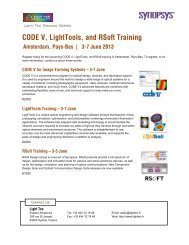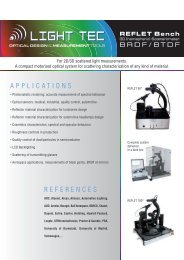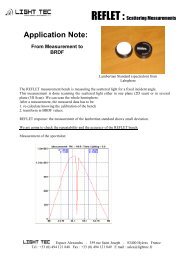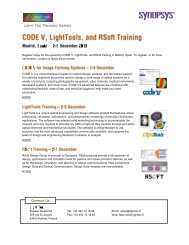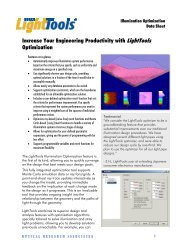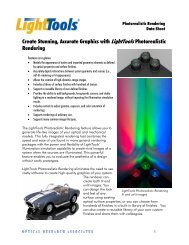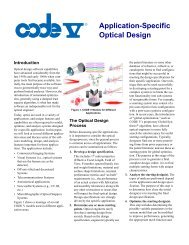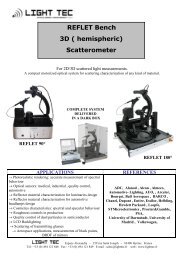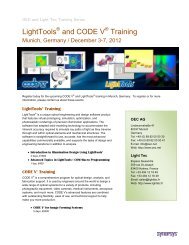Tolerancing with Code V - Light Tec
Tolerancing with Code V - Light Tec
Tolerancing with Code V - Light Tec
Create successful ePaper yourself
Turn your PDF publications into a flip-book with our unique Google optimized e-Paper software.
CODE V <strong>Tolerancing</strong>:<br />
A Key to Product Cost<br />
Reduction<br />
A critical step in the design of an<br />
optical system destined to be<br />
manufactured is to define a fabrication<br />
and assembly tolerance budget and to<br />
accurately predict the resulting asbuilt<br />
performance, including the<br />
effects of compensation (e.g.,<br />
refocus). In addition, determining the<br />
best set of compensators from among<br />
several choices can have a significant<br />
impact on both the recurring and nonrecurring<br />
costs. This complex process<br />
is often simply called, “tolerancing.”<br />
CODE V is a comprehensive software<br />
package for the design, analysis,<br />
tolerancing, and fabrication support of<br />
optical systems. It is one of two<br />
advanced optical engineering software<br />
packages offered by Optical Research<br />
Associates (ORA ® ). CODE V is used<br />
by organizations around the world to<br />
design a wide range of optical systems<br />
for a variety of products, including<br />
photographic equipment, medical<br />
instruments, aerospace systems,<br />
telecommunication components,<br />
microlithographic stepper systems,<br />
and much more. Many of the<br />
companies and users who have chosen<br />
CODE V do so for its advanced<br />
algorithms and features related to<br />
tolerancing and optimization.<br />
Why Is <strong>Tolerancing</strong><br />
Important?<br />
In a word, cost. Many optical design<br />
software packages will do a<br />
reasonable job of optimizing a design<br />
to have good as-designed<br />
performance. However, if small<br />
variations in the values of the lens<br />
parameters result in significant loss of<br />
performance even after compensation<br />
is applied, the cost to build the design<br />
can be prohibitively high. To<br />
minimize production costs, the ideal<br />
optical system design will maintain<br />
the required performance <strong>with</strong><br />
achievable component and assembly<br />
tolerances, using well-chosen postassembly<br />
adjustments. CODE V’s<br />
unique suite of tolerancing capabilities<br />
can help to make this ideal system a<br />
reality.<br />
What Makes<br />
<strong>Tolerancing</strong> <strong>with</strong><br />
CODE V So<br />
Successful?<br />
In two words, speed and accuracy.<br />
Many optical design software<br />
packages have features for<br />
tolerancing, but the algorithmic<br />
approach often requires extremely<br />
long computation times to achieve<br />
accurate results. CODE V includes a<br />
Wavefront Differential tolerancing<br />
method that is extremely fast and<br />
accurate. Using this method,<br />
tolerancing becomes part of the design<br />
process, not just an end-of-the-project<br />
analysis. In addition, it becomes<br />
practical to compare the as-built<br />
performance of competing design<br />
forms or competing compensation<br />
approaches to determine the best<br />
system configuration that includes the<br />
impact of manufacturing and<br />
alignment issues.<br />
Features of CODE V’s Wavefront Differential <strong>Tolerancing</strong><br />
The significant features of CODE V’s TOR option include:<br />
• Performance metrics of RMS wavefront error, diffraction MTF, and single mode fiber<br />
insertion loss (<strong>with</strong> polarization-dependent loss available soon).<br />
• An inverse sensitivity mode, where CODE V determines each tolerance value <strong>with</strong>in<br />
user-defined limits such that each tolerance contributes about equally to the system<br />
performance degradation for the worst case field and zoom position.<br />
- A sensitivity analysis to the current tolerance set is also supported, along <strong>with</strong><br />
the ability to do an inverse sensitivity analysis <strong>with</strong> a subset of tolerances<br />
“frozen” so that their value remains fixed.<br />
• Tolerance sensitivities and performance predictions listed for every field and zoom,<br />
<strong>with</strong> either common or independent compensation across field and zoom.<br />
• Tolerance and compensator labels to assign specific compensators to specific<br />
tolerances.<br />
• The ability to force compensation based on field symmetry <strong>with</strong>out requiring<br />
additional field points to be entered.<br />
• The ability to assign tolerances and compensators to a specific configuration of a<br />
multi-configuration lens (i.e., a specific “zoom” position).<br />
• The ability to override tolerance limits for each supported tolerance type.<br />
• The ability to create a new tolerance by grouping individual tolerances.<br />
- Allows accurate tolerancing of double-pass systems or systems <strong>with</strong> parametric<br />
relationships among the constructional data (such as the front and rear radii<br />
and center thickness of a ball lens).<br />
• The ability to predict changes in distortion (or calibrated distortion) due to tolerances<br />
• The ability to compensate for image quality while simultaneously correcting line-ofsight<br />
errors (i.e., boresight correction) and magnification errors, due to tolerances.<br />
• The ability to define different tolerance probability distributions for different classes<br />
of tolerances.<br />
Additional features and capabilities will be added to future releases.<br />
1
Two Traditional<br />
Approches to<br />
<strong>Tolerancing</strong><br />
To understand the advantages of<br />
CODE V’s tolerancing method, it is<br />
worthwhile to review two traditional<br />
methods, Finite Differences and<br />
Monte Carlo analyses.<br />
The Finite Differences approach<br />
individually varies each parameter<br />
<strong>with</strong>in its tolerance range and predicts<br />
the system performance degradation<br />
on a tolerance-by-tolerance basis.<br />
These individual results are<br />
statistically combined to yield a total<br />
system performance prediction. This<br />
method accurately predicts<br />
performance sensitivity to individual<br />
tolerances, which allows<br />
determination of the parameters that<br />
are “performance drivers.” However,<br />
since the Finite Differences method<br />
does not consider how simultaneous<br />
parameter changes by multiple<br />
tolerances will interact, its prediction<br />
of overall performance is typically<br />
optimistic. The effects of tolerance<br />
interactions on the system<br />
performance are known as “crossterms.”<br />
The Monte Carlo approach is to vary<br />
all of the parameters that have an<br />
associated tolerance by random<br />
amounts, but <strong>with</strong>in each tolerance<br />
range. The resulting system<br />
performance is analyzed. This process<br />
is repeated many times <strong>with</strong> different<br />
random perturbations (each analysis is<br />
often referred to as a “trial”). If many<br />
trials are run (100 to 1000 is typical),<br />
an accurate statistical prediction of the<br />
probability of achieving a particular<br />
performance level can be generated.<br />
Since all the parameters are being<br />
varied at the same time, the Monte<br />
Carlo method accurately accounts for<br />
cross-terms. However, no information<br />
can be gleaned from the Monte Carlo<br />
analysis about individual tolerance<br />
sensitivities. Therefore, while you<br />
can accurately predict system as-built<br />
performance, you cannot determine<br />
the significant parameters that are<br />
driving the performance, and thus<br />
cannot select the best set of tolerances<br />
to minimize cost.<br />
Both the Finite Differences and Monte<br />
Carlo tolerancing methods are very<br />
computationally intensive and can be<br />
very slow. For Finite Differences, the<br />
system must be analyzed twice, once<br />
for each tolerance (i.e., the plus and<br />
minus perturbation). Thus, more<br />
complex systems will take longer to<br />
“tolerance” than simpler systems. A<br />
triplet typically has over 50 tolerances,<br />
resulting in over 100 analysis<br />
simulations. For the Monte Carlo<br />
approach, the system must be<br />
analyzed for every trial. System<br />
complexity is less of an issue, but the<br />
accuracy of the performance<br />
prediction increases as the number of<br />
trials is increased. A hundred to a<br />
thousand analysis simulations are<br />
typical. Analyzing a complex system<br />
to high accuracy using both the Finite<br />
Differences and Monte Carlo methods<br />
can require many hours (or even days)<br />
of analysis time.<br />
CODE V <strong>Tolerancing</strong><br />
Capabilities<br />
While CODE V supports both the<br />
Finite Differences and Monte Carlo<br />
methods, the primary tolerance<br />
analysis feature of CODE V uses a<br />
unique Wavefront Differential<br />
algorithm that is very fast, and<br />
provides information about both<br />
individual tolerance sensitivities (like<br />
the Finite Differences method) and an<br />
accurate performance prediction,<br />
including the effect of cross-terms<br />
(like the Monte Carlo method). For<br />
tolerances that cause a small change to<br />
the overall performance, the wavefront<br />
differential method can also be more<br />
accurate than Finite Differences,<br />
which can suffer numerical precision<br />
problems when subtracting two large<br />
performance numbers to determine a<br />
small difference.<br />
The reason that the Wavefront<br />
Differential approach is so fast<br />
compared to either the Finite<br />
Differences or Monte Carlo<br />
methodologies is that the nominal<br />
system is ray traced once, and all the<br />
required information for further<br />
analysis is extracted by CODE V<br />
algorithms from this ray trace of the<br />
nominal system.<br />
The algorithmic foundation for the<br />
Wavefront Differentials analysis<br />
method is based on the work of<br />
Hopkins & Tiziani 1 , King 2 and<br />
Optical Research Associates’ Chief<br />
Scientist, Matthew Rimmer 3,4 . The<br />
detailed algorithms developed by Mr.<br />
Rimmer are used in CODE V’s<br />
tolerancing feature (TOR), MTF<br />
optimization feature, and automatic<br />
alignment feature (ALI). They were<br />
first implemented in CODE V in 1978,<br />
decades prior to any other commercial<br />
implementation. The CODE V<br />
Wavefront Differential algorithms<br />
have been continually enhanced since<br />
they were first introduced, and include<br />
many proprietary features and<br />
advanced capabilities not found in any<br />
other software package.<br />
Assumptions of the<br />
Wavefront Differential<br />
Method<br />
The accuracy of the Wavefront<br />
Differential method is subject to a few<br />
assumptions. The primary assumption<br />
is that ray optical path differences<br />
(OPDs) due to tolerance perturbations<br />
vary linearly <strong>with</strong> tolerance change.<br />
This assumption is typically valid if<br />
the tolerance perturbation results in a<br />
small degradation of the nominal<br />
performance. This is in fact what the<br />
designer typically tries to achieve<br />
when tolerancing a system. Also, the<br />
Wavefront Differential method is only<br />
applicable to performance metrics that<br />
can be computed by analyzing the<br />
complex field at the exit pupil of the<br />
system. The metrics currently<br />
implemented in CODE V are RMS<br />
wavefront error, diffraction MTF, and<br />
fiber coupling insertion loss<br />
(polarization-dependent insertion loss<br />
will be added soon). Additionally,<br />
development of the Wavefront<br />
Differential equations requires<br />
knowledge of how each tolerance<br />
affects the system. This means that<br />
CODE V’s TOR option will only<br />
analyze pre-programmed (i.e., builtin)<br />
tolerance types. A final<br />
assumption of Wavefront Differential<br />
tolerancing method implemented in<br />
CODE V is that the overall<br />
performance probability has a<br />
Gaussian form, defined by a mean and<br />
sigma. This assumption is typically<br />
2
valid if each tolerance is contributing<br />
about the same to the overall<br />
performance degradation (exactly<br />
what the inverse sensitivity mode of<br />
TOR tries to achieve). When this is<br />
not the case, the Gaussian probability<br />
assumption tends to be conservative.<br />
It is important to understand that<br />
CODE V’s TOR option does include<br />
cross-terms. Wavefront differentials<br />
are computed for each individual<br />
tolerance and for every pair of<br />
tolerances, so these important factors<br />
are included in the overall predicted<br />
performance for the system.<br />
For optical engineers who are<br />
accustomed to alternative tolerance<br />
methods such as finite differences or<br />
Monte Carlo, the fast wavefront<br />
differential method can be effectively<br />
used in concert <strong>with</strong> other methods.<br />
Users often take advantage of the<br />
speed of the Wavefront Differential<br />
Table 1. CODE V’s tolerancing methods<br />
method’s inverse sensitivity analysis<br />
to quickly determine appropriate<br />
tolerances and compensator(s). A<br />
single Monte Carlo analysis of the<br />
resulting system (consisting of a large<br />
number of trials) can provide<br />
assurance of the accuracy of the<br />
wavefront differential performance<br />
prediction. After gaining experience<br />
<strong>with</strong> the Wavefront Differential<br />
method, most users will find that the<br />
extra Monte Carlo analysis step is<br />
unnecessary.<br />
The applicability of CODE V’s<br />
Wavefront Differential tolerancing<br />
method to real system tolerancing is<br />
borne out by the ORA Engineering<br />
Services Group’s successful use of the<br />
TOR option to define tolerances and<br />
analyze as-built performance for over<br />
a thousand fabricated designs. Add to<br />
this the additional thousands of<br />
systems successfully analyzed and<br />
fabricated by CODE V customers<br />
around the world, and you realize that<br />
TOR can be a powerful feature in<br />
your optical design toolkit as well.<br />
The Three <strong>Tolerancing</strong><br />
Methods Compared<br />
For those cases where CODE V’s<br />
Wavefront Differential method does<br />
not support the desired performance<br />
metric, where the tolerances are large<br />
such that ray OPDs do not vary<br />
linearly <strong>with</strong> tolerance change, or<br />
where tolerances are desired that are<br />
not currently pre-defined in CODE V,<br />
the program also supports Finite<br />
Differences and Monte Carlo<br />
tolerancing.<br />
Table 1 compares CODE V’s different<br />
tolerancing methods.<br />
Algorithm CODE V Feature Supported Performance<br />
Metric<br />
Supported Tolerances<br />
Comments<br />
Wavefront<br />
Differentials<br />
TOR • RMS Wavefront Error<br />
• Diffraction MTF<br />
• Fiber Coupling Efficiency<br />
into a SMF<br />
• Polarization Dependent<br />
Loss into a SMF<br />
CODE V pre-programmed<br />
tolerances (e.g., DLR,<br />
DLT, TIR, BTI, etc.)<br />
• Very fast<br />
• Very accurate for tolerances that<br />
result in a small degradation in<br />
system performance (includes<br />
cross-terms)<br />
• Provides individual tolerance<br />
sensitivities AND accurate<br />
performance prediction<br />
• Both Inverse Sensitivity &<br />
Sensitivity analysis supported<br />
Finite<br />
Differences<br />
TOLFDIF<br />
Any quantity that CODE V can<br />
compute<br />
CODE V pre-programmed<br />
tolerances & User-defined<br />
tolerances<br />
• Can be slow depending on<br />
number of tolerances, fields,<br />
zooms and type of performance<br />
metric analyzed.<br />
• Provides accurate individual<br />
tolerance sensitivities,<br />
particularly for larger tolerances<br />
• Performance summary is<br />
optimistic since this method does<br />
not include cross-terms.<br />
• Performance summary is<br />
approximate since this method<br />
assumes that the performance<br />
variation is quadratic <strong>with</strong><br />
tolerance. This assumption may<br />
not be valid for the requested<br />
performance metric<br />
Monte Carlo<br />
Simulation<br />
TOLMONTE<br />
Any quantity that CODE V can<br />
compute<br />
CODE V pre-programmed<br />
tolerances & User-defined<br />
tolerances<br />
• Can be slow depending on the<br />
number of trials requested and<br />
type of performance metric<br />
analyzed.<br />
• Provides accurate performance<br />
prediction (if many trials are<br />
requested), but no information<br />
about individual tolerance<br />
sensitivities<br />
3
Example System: F/2.5<br />
Double Gauss<br />
Objective<br />
Let’s illustrate these different<br />
tolerancing methods on a common<br />
example. The example is an F/2.5<br />
Double Gauss lens <strong>with</strong> a default set<br />
of CODE V tolerances (50 centered<br />
tolerances such as thickness, index,<br />
power and irregularity & 16<br />
decentered tolerances such as wedge,<br />
element tilt and element decenter). See<br />
Figure 1.<br />
The performance metric is the<br />
tangential MTF at 15 cycles/mm and<br />
the only allowed compensation is a<br />
longitudinal shift of the image plane<br />
(i.e., refocus). For this analysis all<br />
parameters are assumed to have an<br />
equal probability of having any value<br />
<strong>with</strong>in the plus and minus tolerance<br />
limits. In actuality, the tolerance<br />
probability distribution can be<br />
modified in CODE V for different<br />
classes of tolerances. The system will<br />
be analyzed for five field positions<br />
(on-axis, +/-70% field, and +/- Full<br />
Field).<br />
Before we discuss the results, it is<br />
noteworthy to compare the speed of<br />
the Wavefront Differential method<br />
relative to a Finite Differences or<br />
Monte Carlo method (Table 2).<br />
The time required to fully tolerance<br />
the system using the Wavefront<br />
Differential method is approximately<br />
equivalent to running a single trial<br />
<strong>with</strong> Monte Carlo. This makes sense<br />
since each trial of Monte Carlo<br />
requires a ray trace of the system, and<br />
that is all that the Wavefront<br />
Differential method requires for its<br />
complete analysis.<br />
Table 2. Speed comparison of tolerancing methods<br />
<strong>Tolerancing</strong> Method<br />
Wavefront Differential (TOR)<br />
Finite Difference (TOLFDIF)<br />
Monte Carlo – 1000 trials<br />
(TOLMONTE)<br />
F/2.5 Double Gauss Scale: 1.40 ORA 11-Nov-02<br />
Figure 1. F/2.5 Double Gauss Lens<br />
Finite Differences tolerancing<br />
provides information about individual<br />
tolerance sensitivities. Table 3 shows<br />
a comparison between the Wavefront<br />
Differentials and Finite Differences<br />
results for the change of radius<br />
tolerance on surface 5. Note<br />
the predicted compensation<br />
motion (included in the<br />
wavefront differential<br />
equations in TOR and via<br />
optimization in TOLFDIF)<br />
along <strong>with</strong> the predicted<br />
compensator motion range<br />
for all tolerances (to handle<br />
98%, or 2-sigma of the<br />
systems). The results<br />
correlate very well.<br />
Next, we compare the<br />
cumulative probability<br />
performance summary for<br />
the three methods. These are<br />
listed in terms of MTF<br />
Computation Time for PIII<br />
1GHz PC<br />
6-seconds<br />
6.7-minutes (67 x TOR)<br />
3.0-hours (1800 x TOR)<br />
17.86 MM<br />
degradation at different probability<br />
levels. The way to read the table is<br />
that the MTF for a given field will<br />
have the indicated degradation or less<br />
for 50%, 84%, 98%, etc. of built<br />
systems (Table 4).<br />
Table 3. Comparison of Wavefront Differentials and<br />
Finite Differences results<br />
Single Tolerance Comparison<br />
(Delta Radius of surface 5, +/- 0.025)<br />
Field<br />
TOR Results<br />
Change in MTF (tangential) at<br />
15 cycles/mm<br />
- Tol. + Tol.<br />
1 (On-axis) -0.017 0.013<br />
2 (+10 deg) -0.007 0.001<br />
3 (+14 deg) 0.006 -0.009<br />
4 (-10 deg) -0.007 0.001<br />
5 (-14 deg) 0.006 -0.009<br />
Compensator (refocus) Motion = -0.116363<br />
2Σ Comp. Motion for all tol. = +/-0.5482<br />
Field<br />
TOLFDIF Results<br />
Change in MTF (tangential) at<br />
15 cycles/mm<br />
- Tol. + Tol.<br />
1 (On-axis) -0.013 0.011<br />
2 (+10 deg) -0.011 0.005<br />
3 (+14 deg) 0.008 -0.011<br />
4 (-10 deg) -0.012 0.005<br />
5 (-14 deg) 0.008 -0.011<br />
Compensator (refocus) Motion = -0.118785<br />
2Σ Comp. Motion for all tol. = +/-0.5476<br />
4
Table 4. Cumulative performance summary for three<br />
tolerancing methods<br />
Double Gauss - U.S.<br />
Tolerance Analysis<br />
ORA<br />
21-Jan-03<br />
F1: 15.00 c/mm, tan<br />
F2: 15.00 c/mm, tan<br />
F3: 15.00 c/mm, tan<br />
F4: 15.00 c/mm, tan<br />
F5: 15.00 c/mm, tan<br />
Performance Summary Comparison<br />
Change in TAN MTF at 15 cycle/mm<br />
CUMULATIVE PROBABILITY<br />
TOR Results<br />
Field 50.0% 84.1% 97.7% 99.9%<br />
1 -0.047 -0.100 -0.153 -0.206<br />
2 -0.062 -0.150 -0.238 -0.327<br />
3 -0.053 -0.125 -0.198 -0.270<br />
4 -0.062 -0.150 -0.238 -0.327<br />
5 -0.053 -0.125 -0.198 -0.270<br />
TOLFDIF Results<br />
1 -0.049 -0.083 -0.116 -0.150<br />
2 -0.063 -0.127 -0.190 -0.254<br />
3 -0.047 -0.099 -0.152 -0.204<br />
4 -0.072 -0.136 -0.199 -0.263<br />
5 -0.059 -0.113 -0.168 -0.223<br />
TOLMONTE Results - 1000 trials<br />
1 -0.047 -0.103 -0.168 -0.237<br />
2 -0.053 -0.134 -0.257 -0.380<br />
3 -0.037 -0.129 -0.264 -0.422<br />
4 -0.048 -0.143 -0.292 -0.477<br />
5 -0.049 -0.150 -0.317 -0.422<br />
Cumulative Probability (%)<br />
Double Gauss - U.S. Patent 2,532<br />
Monte Carlo (1000 trials)<br />
ORA<br />
100.<br />
90.<br />
80.<br />
70.<br />
60.<br />
50.<br />
40.<br />
30.<br />
20.<br />
10.<br />
0.<br />
1.000 0.800 0.600 0.400 0.200 0.000<br />
Modulation Transfer Function<br />
Figure 2. Wavefront Differentials cumulative probability plot<br />
100.<br />
21-Jan-03<br />
Field 1<br />
Field 2<br />
Field 3<br />
Field 4<br />
Field 5<br />
90.<br />
The results correlate well, especially<br />
on-axis and at the lower performance<br />
probabilities off-axis. The Finite<br />
Differences prediction is somewhat<br />
optimistic since it does not include<br />
cross-terms. The correlation between<br />
the Wavefront Differentials method<br />
and the Monte Carlo method does<br />
diverge at the higher probabilities for<br />
the off-axis points. These differences<br />
can be understood by examining the<br />
cumulative probability performance<br />
plots.<br />
All three of the CODE V tolerancing<br />
methods discussed in this paper create<br />
a cumulative probability performance<br />
plot. This allows users to determine<br />
the performance at any probability<br />
level. Figure 2 is the cumulative<br />
probability plot generated by the<br />
Wavefront Differentials tolerancing<br />
method (TOR). Figure 3 is the<br />
cumulative probability plot generated<br />
by the Monte Carlo method<br />
(TOLMONTE). You can see that at<br />
the higher probabilities, the Monte<br />
Carlo curves have significant “tails.”<br />
This, and the fact that the Monte Carlo<br />
results are not symmetric for<br />
symmetric fields, suggest that more<br />
trials may be required for improved<br />
accuracy.<br />
80.<br />
Conclusion<br />
70.<br />
CODE V’s<br />
60.<br />
optimization<br />
50.<br />
capabilities have<br />
40.<br />
long been the<br />
recognized as the<br />
30.<br />
best in the industry<br />
20.<br />
for achieving<br />
10.<br />
optimum nominal<br />
0.<br />
performance <strong>with</strong><br />
minimized system<br />
complexity.<br />
However, for<br />
systems destined<br />
for fabrication,<br />
outstanding nominal performance is<br />
only the first step to a successful<br />
product.<br />
This paper demonstrates how<br />
CODE V’s advanced tolerancing<br />
features provide outstanding speed,<br />
accuracy, and flexibility, which<br />
ultimately help you to maintain optical<br />
system performance while reducing<br />
costs during product development, and<br />
throughout the product life cycle.<br />
References<br />
Cumulative probability (%)<br />
1. H.H. Hopkins and H.J. Tiziani,<br />
“A theoretical and experimental<br />
study of lens centering errors and<br />
their influence on optical image<br />
1.000 0.800 0.600 0.400 0.200 0.000<br />
TAN MTF at 15 cyc/mm<br />
Figure 3. Monte Carlo cumulative probability plot<br />
quality”, Brit. J. Appl, Phys., Vol.<br />
17, 33 (1966)<br />
2. W. B. King, “Use of the<br />
Modulation-Transfer Function<br />
(MTF) as an Aberration-<br />
Balancing Merit Function in<br />
Automatic Lens Design”, JOSA,<br />
Vol 59, 1155 (1969)<br />
3. M. Rimmer, “Analysis of<br />
Perturbed lens Systems”, Appl.<br />
Opt., Vol 9, 533 (1970)<br />
4. M. Rimmer “A <strong>Tolerancing</strong><br />
Procedure Based on Modulation<br />
Transfer Function (MTF),” SPIE,<br />
Vol. 147, 66 (1978)<br />
5
About ORA<br />
Optical Research Associates (ORA ® ) is the industry’s leading supplier of imaging and illumination design/analysis<br />
software: CODE V ® and <strong>Light</strong>Tools ® . Our Engineering Services group is the largest independent supplier of optical<br />
systems design <strong>with</strong> more than 4,500 completed projects in imaging, illumination, and optical systems engineering.<br />
ORA was founded in 1963 to provide leading-edge optical design services. ORA’s primary vision ⎯ to accelerate<br />
the development and adoption of optical technology throughout the world ⎯ has led to its definitive role as an<br />
innovative solutions supplier to the optics industry.<br />
© 2003 Optical Research Associates. All rights reserved. <strong>Light</strong>Tools, CODE V, and ORA are registered trademarks<br />
of Optical Research Associates. This document is protected by copyright. No part of this document may be<br />
reproduced or reprinted <strong>with</strong>out permission in writing from Optical Research Associates.<br />
3280 East Foothill Boulevard, Pasadena, California 91107<br />
Telephone: (626) 795-9101 FAX: (626) 795-9102<br />
6<br />
E-mail: service@opticalres.com Web Site: www.opticalres.com



